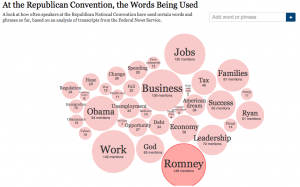Guest blogging today over at the International Institute for Qualitative Methodology… check it out.
Category Archives: Uncategorized
simple word counts & data displays
While simply counting words and phrases doesn’t provide a deep analysis of text, it can be a start in identifying basic themes or ideas for further analysis. This example from the NY Times is a simple count of frequently used words and phrases during the Republican party’s convention. The intermediate analysis value lies in part in the graphic illustration of the word count and the quick reference to examples of full text where those words/phrases appear. The graphic quickly orients the viewer to the fact that the candidates are most frequently mentioned (as is the anti-candidate Obama) ~ not to surprising, but also to those ideas that are most present in the speeches, for example, work, business and jobs are the main theme followed by leadership, families and god. Clicking on any word or phrase then highlights it in context in excerpts from variou speeches.
How many interviews is enough?
Especially when using a grounded theory approach, seldom can this question be easily answered. In this research note, which reviews grounded theory studies that used interviewing as the primary data collection method, the author finds that typically 10 – 30 interviews are the normative range, although overall the range is from a low of 4 to more than 100 interviews.
The number of interviews depends on:
1) the research question: when the question is more focused fewer interviews are usually necessary
2) the researcher’s familiarity with the topic: increased knowledge may mean fewer interviews
3) single or multiple interviews: multiple interviews with a respondent may mean fewer interviews are necessary
But, at the end of the day, the primary decision factor is still theoretical saturation, which can only be assessed once data collection and analysis has begun.
some advice on writing that paper
Here is a ppt, Plotting an Academic Paper, from Mary Dixon-Woods, Professor of Medical Sociology at the University of Leicester, that might help in developing an approach to writing or get you unstuck if you aren’t making much headway.
description of most data analysis software
This website describes the details of most software currently available for doing qualitative data analysis.
This is a very simple free program that you might want to check out. It does not have the bells and whistles of commercial software packages, but might be useful for getting started.
Call for proposals ~ Congress of Qualitative Inquiry
The next Congress will be held at the University of Illinois from May 20-23, 2009. Click here for details.

 Follow
Follow

